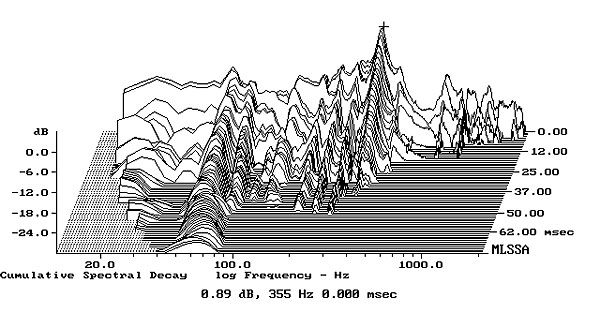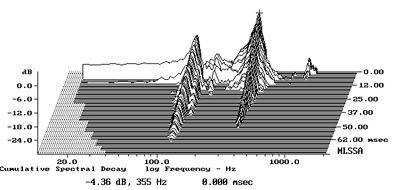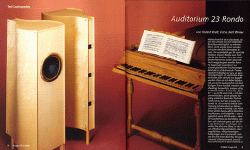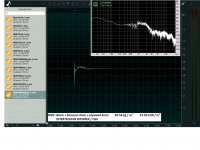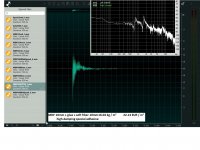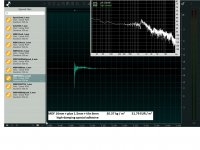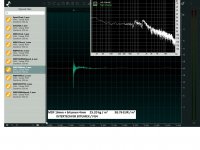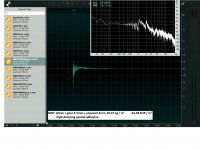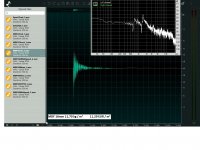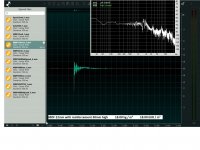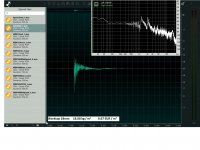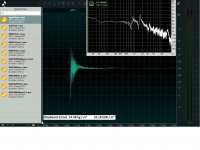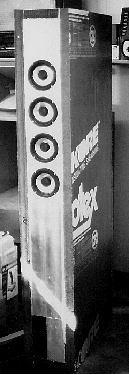Unfortunately you have to be a bit careful when it comes to BBC type speakers. Assuming they are one of the thin-wall types, the question becomes whether they follow the BBC criteria, or if they are simply 'inspired by' (which could mean anything). Even some companies with considerable heritage on this front have done just that, departing significantly, as can be seen above, from the basic BBC design stipulations, either in panel materials, an absense (relative or total) of panel damping, lack of sufficiently rigid battons etc. I nearly went into orbit when I saw the mess one manufacturer had made of an LS3/6 cabinet. Or another with one of their 'inspired by' designs. A 'favourite' of mine is a manufacturer who shamelessly dribbles about how they follow the BBC design method, but do not use any panel damping at all, to allow the cabinet 'to breath in time with the bass driver'.
Give me strength. Somebody. Please. Give me strength.
Give me strength. Somebody. Please. Give me strength.
Last edited:
Surely you are a fanboy of overdamped speaker cab designs, your post makes that statement.
You are unable to imagine that any other than a totally damped cabinet could sound good.
And a cab., with resonating walls is the hell for you. Understood.
But what, if I tell to you, that a controlled resonance cabinet, made here in germany, have won several prices for good sound?
Its the A23 Rondo. Pure hell, but heavenly sounding. Totally undamped. Higly resonant. High efficiency.
You may never had heard of those. As you may never had heard of so many other great resonant designs in audio history.
You, the fanboy of so many overdamped to death speaker designs.
You are unable to imagine that any other than a totally damped cabinet could sound good.
And a cab., with resonating walls is the hell for you. Understood.
But what, if I tell to you, that a controlled resonance cabinet, made here in germany, have won several prices for good sound?
Its the A23 Rondo. Pure hell, but heavenly sounding. Totally undamped. Higly resonant. High efficiency.
You may never had heard of those. As you may never had heard of so many other great resonant designs in audio history.
You, the fanboy of so many overdamped to death speaker designs.
Attachments
Last edited:
I'll give you this: There is HiFi and then there is MyFi. The turnover on products in the latter category is higher. Beads and mirrors. And people believe. And you know all this. 😉Give me strength. Somebody. Please. Give me strength.
Like a passive radiator? Why couldn't that be made to work?A 'favourite' of mine is a manufacturer who shamelessly dribbles about how they follow the BBC design method, but do not use any panel damping at all, to allow the cabinet 'to breath in time with the bass driver'.
I think you are offensive here. Most here perfectly do understand any speaker concept can sound good. Most here perfectly do understand our ears and brain can and will deceive us. Most of us accept that. Please do so too.You are unable to imagine that any other than a totally damped cabinet could sound good.
...
You, the fanboy of so many overdamped to death speaker designs.
@Juhazi primary resonance in all cases is around 350z. So just below the threshold of increased audibility. This means I should brace sidewalls to push their resonance even higher and I could try leaving front and back panels unbraced but highly damped, as they are 33 by 20 cm, so primary resonance in the 350 hz region.
@Schmitz controlled resonance speakers are outside the scope of my DIY skills and tools but thanks for sharing thatthere are other approaches than thin and damped or thick undamped.
@scottjoplin speaker panels are too stiff for to work like passive radiators, their resonance is simply too high in frequency, unless one makes a really large speaker out of thin material. Passive radiators contribute little to sound lets say an octave above their tuning, which is usually <50hz or more often <30hz. Speaker panels resonate at hundreds of hz and have multiple secondary or tertiary resonances, above and below their primary resonance.
@Schmitz controlled resonance speakers are outside the scope of my DIY skills and tools but thanks for sharing thatthere are other approaches than thin and damped or thick undamped.
@scottjoplin speaker panels are too stiff for to work like passive radiators, their resonance is simply too high in frequency, unless one makes a really large speaker out of thin material. Passive radiators contribute little to sound lets say an octave above their tuning, which is usually <50hz or more often <30hz. Speaker panels resonate at hundreds of hz and have multiple secondary or tertiary resonances, above and below their primary resonance.
Last edited:
Surely you are a fanboy of overdamped speaker cab designs, your post makes that statement... You may never had heard of those. As you may never had heard of so many other great resonant designs in audio history.
You, the fanboy of so many overdamped to death speaker designs.
Really? What makes you say that when you have twice been told the BBC's is not my preferred design approach?
However, you are correct in one sense: a loudspeaker which uses panel resonance to provide a significant component of its output is not, as far as I am concerned, an accurate design. Many may (and yes, I am perfectly familiar with the A23, products from Musical Affairs, Ocellia, Bosendorfer etc., along with their antecedents stretching back to the '40s) produce results that some people enjoy. Which is perfectly fair enough. Their money, their ears, their choice. But it's not accurate. A loudspeaker is not a musical instrument: it reproduces a signal that has already been recorded. Its job, as far as I am concerned, is to add as few audible colourations of its own devising to that signal as possible. I don't find any of my friends who are recording artists wishing to use highly resonant designs either, in studios, or their own homes.
In a similar vein, most thin-wall 'controlled resonance' enclosures, which purport to allow rapid energy decay sadly do not seem to do so in the hard light of test measurements, or whenever I have listened to them. So to date, all of those have essentially fallen by the wayside for me also. If you prefer either (or both) of these approaches however, I'm happy that you have found something you enjoy.
Last edited:
Like a passive radiator? Why couldn't that be made to work?
Not exactly. If you take things far enough back to the underlying physics of MOE, bend / flex ratios, resonant profiles &c. then sure, there are similarities at that base level and it's technically possible to create something that may function in a similar way. However, with a PBR you have very tight control over a relatively limited number of parameters. With enclosure design, especially if using variable wood-based materials, you simply don't have that level of control and / or consistency. Potentially more so with some other materials of course but I can promise you this: the manufacturer I am referring to hasn't done any such thing (I'm not guessing here by the way, speaking from actual knowledge. That's why I'm not giving any names).
If you go the other way though: highly rigid boxes that ring like a bell, but not at any frequency likely to be excited in ordinary speaker operating conditions (i.e. get panel Fs and Q high enough) -then I'm interested. Notwithstanding other issues, CRS, aluminium etc. have a lot of potential in this regard.
Last edited:
"A directional bass-dispersion pattern avoids the ceiling and sidewall reflections, thus reducing such room excitation. In low-mass electrostatic-diaphragm panel dipoles, the back-wave reflection dominates the acoustic impedance or reflected air load on the panel, destructively nulling the output over a range of bass frequencies. The Celestion woofers are high mass, however, and are thus indifferent to the back-wave returning from the rear wall; this eventually arrives delayed and partially diffused at the listening position."
Interesting, I've not hear that before, is the effect that significant?
Interesting, I've not hear that before, is the effect that significant?
Dipole enthusiasts bring the nulling as a pre. The few measurements I encountered seem to justify the claim that room modes are less than with monopoles. Although in a stereo setup the two speakers also reduce modal resonances in the axis through both speakers. It is certainly true that the sound waves in a room hardly affect cones of electrodynamical drivers, as long as those have their voicecoils effectively shortened.
But this of course is completely off-topic. Fine piece of engineering in the eighties, again 😉
But this of course is completely off-topic. Fine piece of engineering in the eighties, again 😉
Last edited:
The test of Celestion System 6000 was written in 1987. Lots of BS in Collom's text, could be from sales brochure? Basically it is a dipole woofer set sideways. Gradient Helsinki has similar.
Actually I can accept thin wall cabinet for BBC LS3 series, becaause it is a rather small box and meant for nearfield monitoring, moderate spl levels. Relative proportion of resonance distortion rises ax box grows up to 3-way models. But still resonance control is something I don't believe can be mastered, only modified. I've done some diy panel resonance measurements and modifications, but I couldn't hear the difference. Validity of mesurements remains a question...
Solid enclosures sounding "dead" I don't understand at all, it's urban legend!
Actually I can accept thin wall cabinet for BBC LS3 series, becaause it is a rather small box and meant for nearfield monitoring, moderate spl levels. Relative proportion of resonance distortion rises ax box grows up to 3-way models. But still resonance control is something I don't believe can be mastered, only modified. I've done some diy panel resonance measurements and modifications, but I couldn't hear the difference. Validity of mesurements remains a question...
Solid enclosures sounding "dead" I don't understand at all, it's urban legend!
One thing for sure is that measurements with accelerometers hardly bring any usable info. Measurement of sound insulation still works best in a two-reflective-room acoustic lab with a dividing wall supplying an opening for the DUT. Thus one relatively easy can compare sound power levels and derive the insulation from that.
Otherwise, BEM simulation actually does the job, if the parameters are set correctly.
Otherwise, BEM simulation actually does the job, if the parameters are set correctly.
An accelerometer would be able to tell you what part is vibrating, and presumably if it's a sine wave it's likely to be caused by air pressure in the inside, if it's not it could be caused by mechanical transmission. It would also exclude the sound of the driver. There's surly no harm in giving it a go; I for one would be interested in the results, even if they prove it was ineffective.
I did time and frequency analysis on the wav files (nocking on 10 panels of different construction) from that old post’s link to feed my own curiosityFound the link to the site where some folks have both measured and recorded the sound of different materials and sandwich combos .... take a look and listen 😉
HAUPT
George
Attachments
Regarding XPS foam board construction - I used Dow Corning "Foamular" 1 inch pink XPS boards. I think it is an excellent material for making a prototype cabinet. With standard wood working power tools (table saw, band saw), it cuts super fast with almost no dust (it is mostly air) and no noise. It glues together very quickly with almost any construction adhesive... I used Loktite PowerGrab. I cut the driver holes with a utility knife. I estimate construction time was 1/5th the time of making a plywood cabinet.
Performance is quite good. I did not brace my cabinet quite well enough, but the next one will be better. I was pleasantly surprised at how low the cabinet signature was.
I speculate that the reason this material performs well is it has a high specific modulas... in other words its stiffness to weight ratio is high. The 1" thick panel foam panel appears to me to be nearly as stiff as 1/2 inch plywood, but it is far lighter. This contributes to a high resonant frequency for the cabinet walls. I took no data, so this is just informed speculation at this point.
Performance is quite good. I did not brace my cabinet quite well enough, but the next one will be better. I was pleasantly surprised at how low the cabinet signature was.
I speculate that the reason this material performs well is it has a high specific modulas... in other words its stiffness to weight ratio is high. The 1" thick panel foam panel appears to me to be nearly as stiff as 1/2 inch plywood, but it is far lighter. This contributes to a high resonant frequency for the cabinet walls. I took no data, so this is just informed speculation at this point.
to monitor and assess broadcast programme quality
Which was often just voice.
dave
I thought I had this saved somewhere... early Bottlehead prototype with 4x MCM 5in alloy cone midbass drivers in a sealed[ish] box built out of 1 5/8in carbon-filled foamcore insulation board with an outer foil layer. Apparently a trifle diaphragmatic in the LF region, but it showed sufficient promise to be developed into a more complete design with MDF or ply panels.
Attachments
- Home
- Loudspeakers
- Multi-Way
- BBC style thin wall enclosure - how thin can one go?
